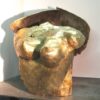The Blessed Apron – hand printed lithography, assorted papers including Chinese New Year envelopes & thread; 48 x 18 x 8 in.
Julie McIntyre
I inherited a box of over 2000 exquisite travel slides my grandmother, Lucy MacLeod McIntyre took during her adventures around the world in the 1960s and 1970s. I sorted the images according to themes from sacred structures to street scenes and Royal guards. Then, using the full-length, bibbed “Grandma Apron” as the template, I have hand-printed her photographic images and sewn them into uniforms my grandmother could have proudly and comfortably worn. Why aprons? Aprons are still among the most recognizable icons of women’s lives, symbolizing not only home and motherhood, but our profound social ambivalence about our expectations of mothers to the degree that apron strings tie unwilling women to the home and restless children to binding relationships.
While I have tried to visualize the wearing of experiences, the grouping of recurrent themes also suggest icons. In The Children’s Apron for instance, hearts, butterflies and pointed roofed houses are classic icons drawn for and by youngsters throughout the world. Printed currency is designed to represent distinct nationalities, but when grouped in The Shopkeeper‘s Apron, recurrent images from Heads of State to landscapes and symbolic colours are similarly used to value countries. Indeed, money can be viewed as one of the most seductive global icon representing for some freedom, others power, but for all opportunity, even if that translates simply to the ability to feed one‘s family. Spiritual icons abound in the major religions and hopefully The Blessed Apron pays respect to the variety of traditions and beliefs.
© Julie McIntyre



